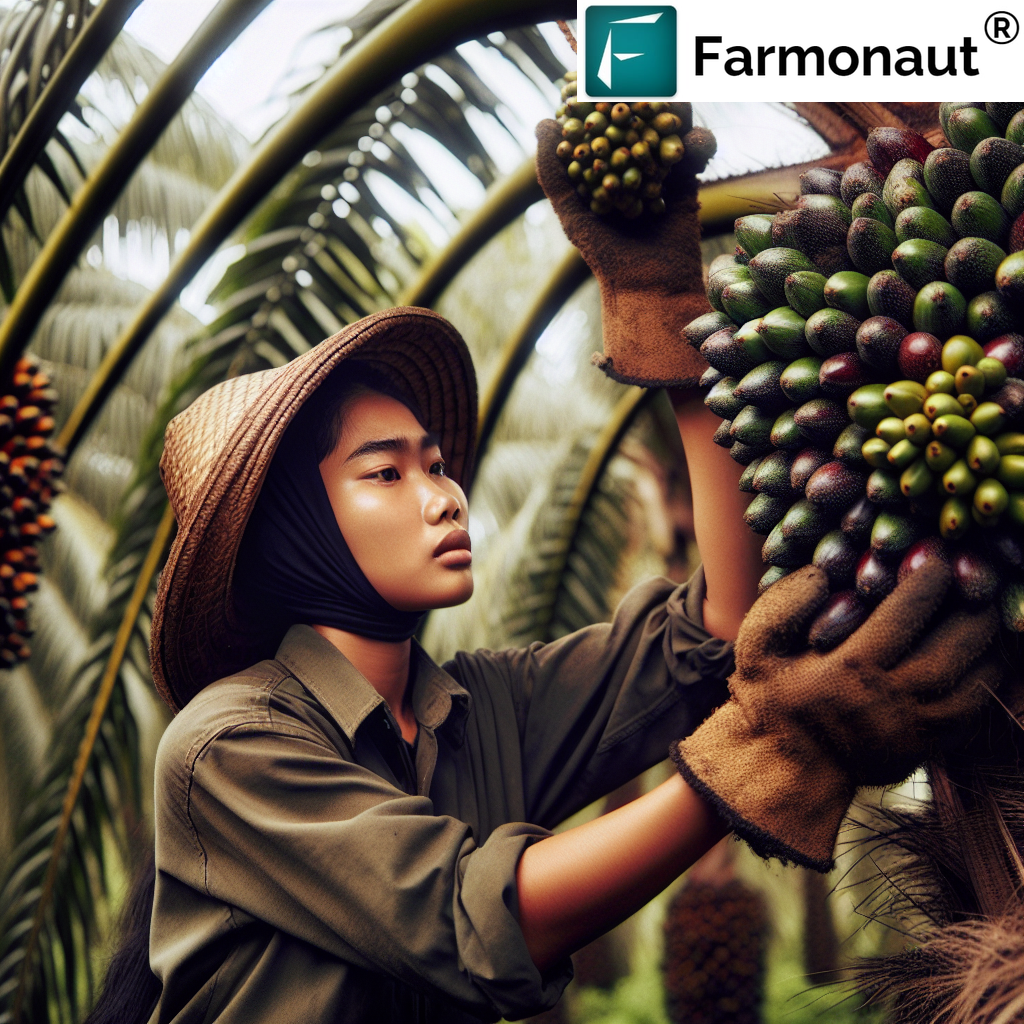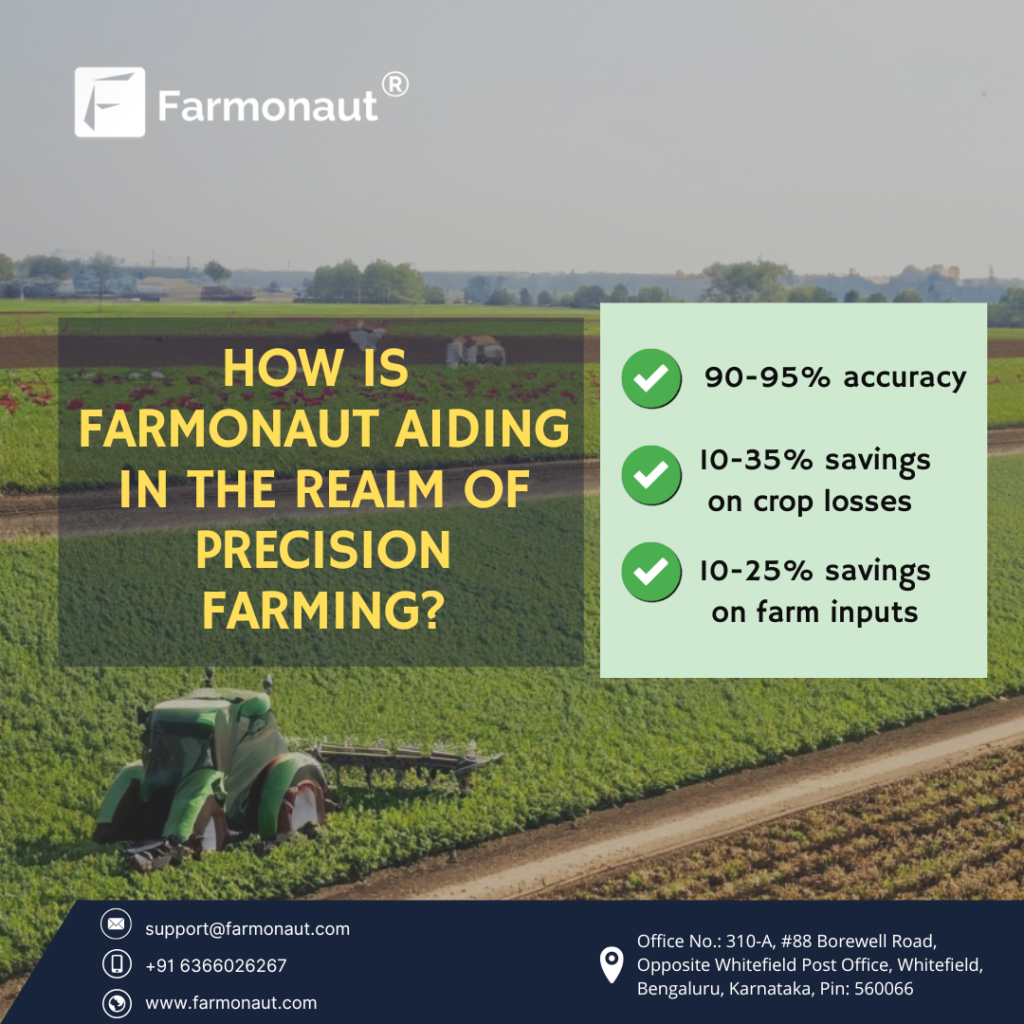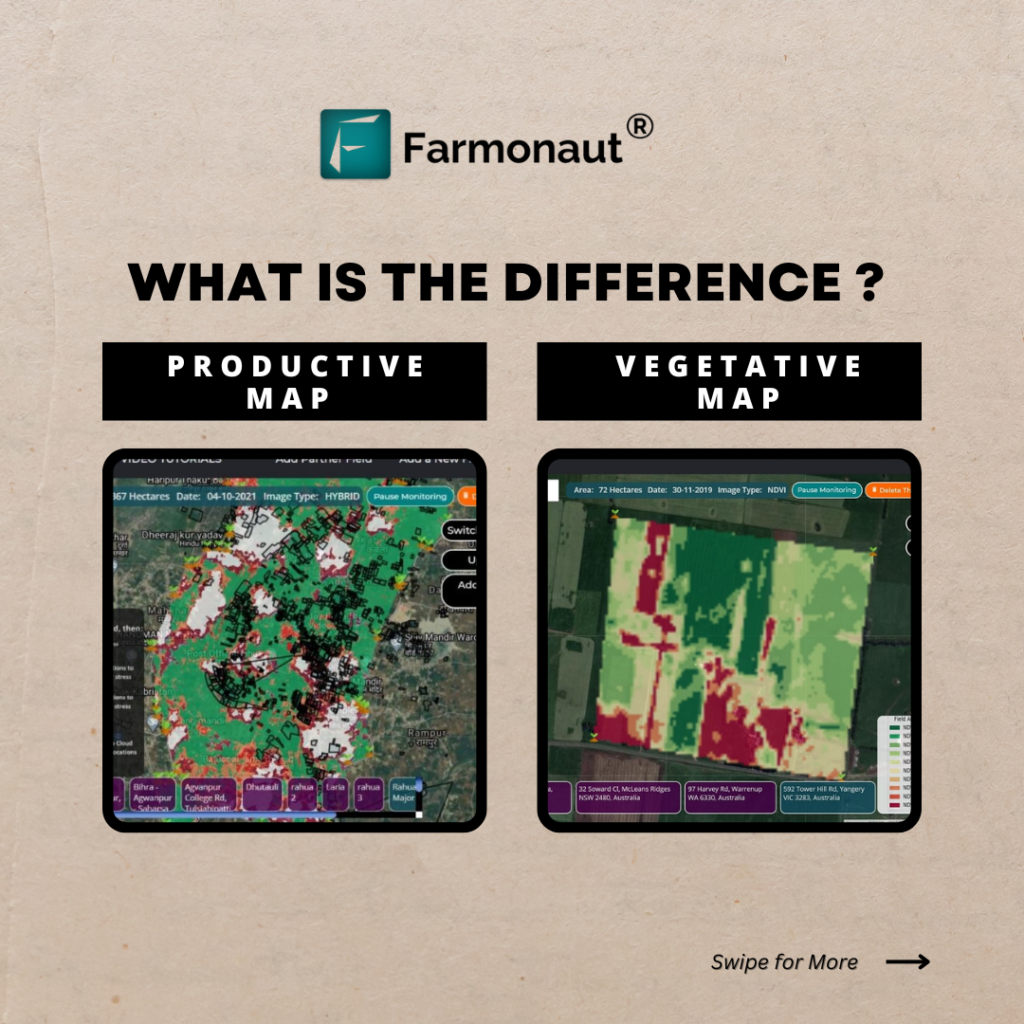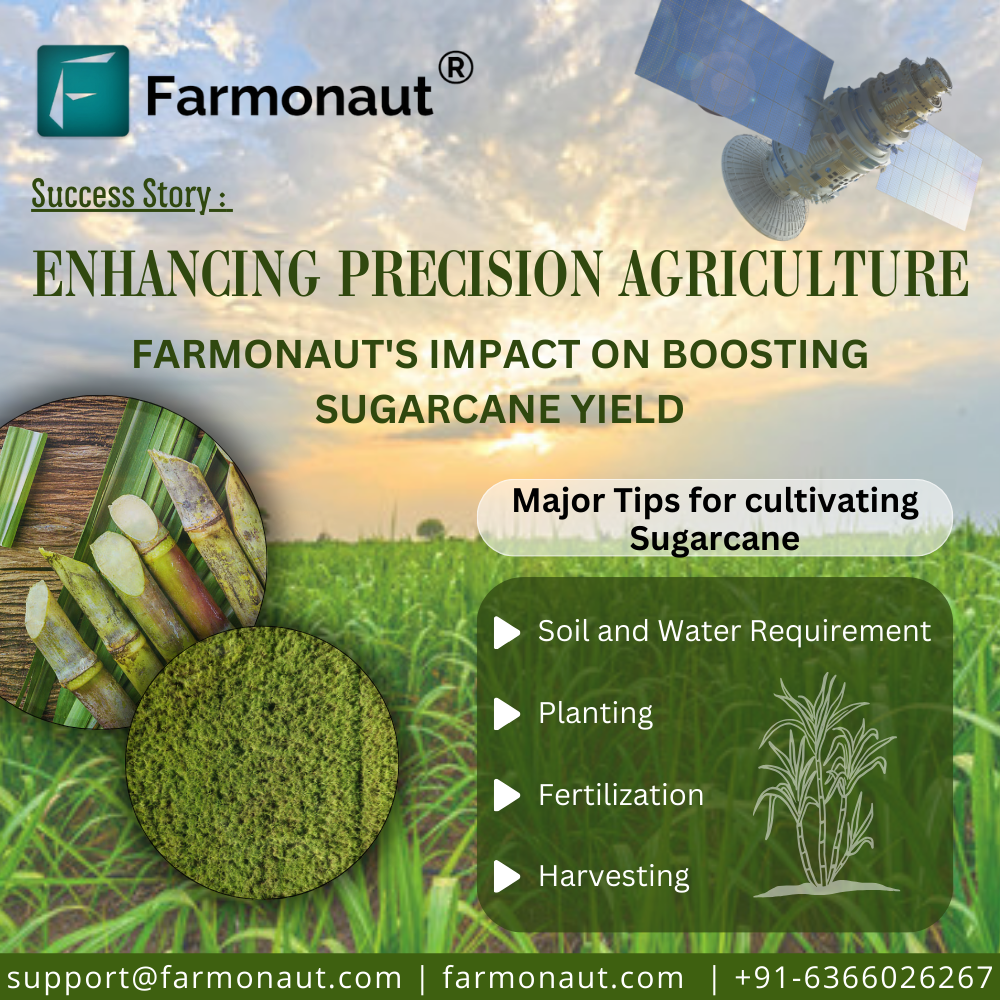Maximizing Profits: A Comprehensive Guide to Palm Tree Farming, Plantations, and Successful Farm Management

Welcome to our comprehensive guide on palm tree farming, plantations, and successful farm management. As experts in agricultural technology and sustainable farming practices, we at Farmonaut are excited to share our knowledge and insights with you. In this extensive blog post, we’ll delve into the world of palm tree cultivation, exploring everything from setting up your plantation to maximizing yields and profits.
Table of Contents
- Introduction to Palm Tree Farming
- Setting Up Your Palm Tree Plantation
- Palm Tree Species and Selection
- Soil Preparation and Planting Techniques
- Irrigation and Water Management
- Fertilization and Nutrient Management
- Pest and Disease Control
- Harvesting and Post-Harvest Handling
- Marketing and Sales Strategies
- Sustainable Practices in Palm Tree Farming
- Leveraging Technology for Improved Palm Tree Farm Management
- Financial Aspects of Palm Tree Plantations
- Challenges and Solutions in Palm Tree Farming
- Future Trends in the Palm Oil Industry
- FAQ Section
1. Introduction to Palm Tree Farming
Palm tree farming has become an increasingly popular and lucrative agricultural venture in recent years. With the growing demand for palm oil, coconuts, and other palm-derived products, establishing a
palm tree plantation can be a wise investment for farmers and entrepreneurs alike.
Palm trees are versatile crops that can be cultivated in various tropical and subtropical regions around the world. They offer numerous benefits, including:
- High yield potential
- Multiple revenue streams from various palm products
- Long productive lifespan (up to 25-30 years)
- Relatively low maintenance requirements once established
- Contribution to environmental sustainability through carbon sequestration
In this guide, we’ll explore the ins and outs of
palm tree farming, providing you with the knowledge and tools necessary to establish and manage successful
palm tree farms.
2. Setting Up Your Palm Tree Plantation
Establishing a thriving
palm tree plantation requires careful planning and execution. Here are the key steps to consider when setting up your palm tree farm:
2.1 Site Selection
Choosing the right location for your palm tree plantation is crucial for its success. Consider the following factors:
- Climate: Most palm species thrive in tropical and subtropical climates with warm temperatures and high humidity.
- Soil type: Well-draining, fertile soils with a pH between 5.5 and 7.5 are ideal for palm trees.
- Topography: Gently sloping or flat land is preferable for easy maintenance and harvesting.
- Water availability: Ensure access to a reliable water source for irrigation.
- Accessibility: Consider proximity to roads and markets for efficient transportation of products.
2.2 Land Preparation
Proper land preparation is essential for establishing a healthy palm tree plantation. Follow these steps:
- Clear the land of existing vegetation and debris.
- Conduct soil tests to determine nutrient levels and pH.
- Apply necessary soil amendments based on test results.
- Plow and level the land to ensure proper drainage.
- Create planting rows and mark planting points.
2.3 Infrastructure Development
Invest in the necessary infrastructure to support your palm tree farm:
- Irrigation system: Install an efficient irrigation system to ensure adequate water supply.
- Roads and pathways: Develop internal roads for easy access to different parts of the plantation.
- Storage facilities: Build storage areas for equipment, fertilizers, and harvested products.
- Processing facilities: Consider setting up on-site processing facilities if applicable.
3. Palm Tree Species and Selection
Selecting the right palm tree species for your plantation is crucial for its success. Here are some popular palm tree species for commercial cultivation:
3.1 Oil Palm (Elaeis guineensis)
Oil palm is the most widely cultivated palm species for commercial purposes, primarily for its high-yielding oil production.
- High oil yield (up to 4-5 tons per hectare per year)
- Productive lifespan of 25-30 years
- Requires warm, humid climate with consistent rainfall
3.2 Coconut Palm (Cocos nucifera)
Coconut palms are versatile trees that provide multiple products, including coconuts, copra, and coir.
- Adapted to various tropical coastal environments
- Long productive lifespan (50-60 years)
- Multiple revenue streams from various coconut products
3.3 Date Palm (Phoenix dactylifera)
Date palms are renowned for their sweet fruit production and are well-suited to arid and semi-arid regions.
- Tolerant to high temperatures and low humidity
- Can produce fruit for up to 100 years
- Requires careful irrigation management
3.4 Acai Palm (Euterpe oleracea)
Acai palms are gaining popularity due to the high demand for their nutrient-rich berries.
- Native to South American rainforests
- Requires high humidity and consistent moisture
- Multi-stemmed palm with potential for continuous harvesting
When selecting palm tree species for your plantation, consider factors such as local climate, market demand, and your specific goals for the farm.
4. Soil Preparation and Planting Techniques
Proper soil preparation and planting techniques are essential for establishing a healthy and productive palm tree plantation. Here’s a detailed look at the steps involved:
4.1 Soil Testing and Amendment
Before planting, conduct comprehensive soil tests to assess:
- Soil pH
- Nutrient levels (N, P, K, and micronutrients)
- Organic matter content
- Soil texture and structure
Based on the test results, amend the soil as necessary:
- Adjust pH using lime (to increase pH) or sulfur (to decrease pH)
- Add organic matter to improve soil structure and fertility
- Apply necessary fertilizers to address nutrient deficiencies
4.2 Planting Density and Spacing
Optimal planting density varies depending on the palm species and local conditions:
- Oil palm: 120-150 trees per hectare (8-9 meters between trees)
- Coconut palm: 150-175 trees per hectare (7-8 meters between trees)
- Date palm: 100-150 trees per hectare (8-10 meters between trees)
- Acai palm: 400-600 clumps per hectare (5-6 meters between clumps)
Proper spacing ensures adequate sunlight, air circulation, and nutrient availability for each tree.
4.3 Planting Techniques
Follow these steps for successful palm tree planting:
- Dig planting holes: Size should be approximately 1m x 1m x 1m
- Add organic matter and fertilizer to the planting hole
- Carefully remove the palm seedling from its container
- Place the seedling in the hole, ensuring the soil level matches the original container
- Backfill the hole with soil, gently firming it around the roots
- Water thoroughly after planting
- Apply mulch around the base of the tree to retain moisture and suppress weeds
4.4 Timing of Planting
The best time to plant palm trees is typically at the beginning of the rainy season or during periods of moderate temperatures. This allows the trees to establish their root systems before facing extreme weather conditions.
5. Irrigation and Water Management
Efficient irrigation and water management are crucial for the success of your palm tree plantation. Here’s what you need to know:
5.1 Water Requirements
Water needs vary depending on the palm species, climate, and soil conditions:
- Oil palm: 1,500-2,500 mm of water per year
- Coconut palm: 1,500-2,000 mm of water per year
- Date palm: 1,800-2,800 mm of water per year (in arid regions)
- Acai palm: Requires consistent moisture, prefers areas with high rainfall
5.2 Irrigation Methods
Choose an irrigation method that suits your plantation size, water availability, and budget:
- Drip irrigation: Efficient water use, reduces weed growth
- Sprinkler systems: Good for larger areas, but less water-efficient
- Flood irrigation: Simple but less efficient, suitable for flat terrains
- Basin irrigation: Effective for individual trees, labor-intensive
5.3 Irrigation Scheduling
Develop an irrigation schedule based on:
- Local climate and rainfall patterns
- Soil moisture levels (use soil moisture sensors for accuracy)
- Growth stage of the palms
- Seasonal variations in water demand
5.4 Water Conservation Techniques
Implement water conservation practices to improve efficiency:
- Mulching to reduce evaporation
- Rainwater harvesting systems
- Cover crops to improve soil water retention
- Regular maintenance of irrigation systems to prevent leaks
6. Fertilization and Nutrient Management
Proper fertilization and nutrient management are essential for optimal growth and yield in palm tree plantations. Here’s a comprehensive guide to ensuring your palms receive the nutrients they need:
6.1 Nutrient Requirements
Palm trees require a balance of macronutrients and micronutrients for healthy growth:
- Macronutrients: Nitrogen (N), Phosphorus (P), Potassium (K), Magnesium (Mg), Calcium (Ca)
- Micronutrients: Iron (Fe), Manganese (Mn), Boron (B), Zinc (Zn), Copper (Cu)
6.2 Soil Testing and Analysis
Regular soil testing is crucial for developing an effective fertilization program:
- Conduct soil tests annually or bi-annually
- Analyze leaf tissue samples to assess nutrient uptake
- Use results to adjust fertilizer applications
6.3 Fertilizer Types and Application Methods
Choose appropriate fertilizers and application methods based on your plantation’s needs:
6.3.1 Organic Fertilizers
- Compost
- Animal manure
- Green manures
- Organic mulches
6.3.2 Inorganic Fertilizers
- NPK blends
- Slow-release fertilizers
- Micronutrient supplements
6.3.3 Application Methods
- Broadcast application
- Band application
- Foliar sprays
- Fertigation (applying fertilizers through irrigation systems)
6.4 Fertilizer Schedule
Develop a fertilizer schedule based on the growth stage of your palms:
- Young palms (1-3 years): More frequent applications with lower doses
- Mature palms (4+ years): Less frequent applications with higher doses
- Adjust schedule based on soil test results and visible signs of nutrient deficiencies
6.5 Nutrient Deficiency Symptoms and Corrections
Be aware of common nutrient deficiency symptoms in palm trees:
- Nitrogen deficiency: Yellowing of older leaves
- Potassium deficiency: Leaf tip necrosis, reduced fruit size
- Magnesium deficiency: Yellowing of leaf margins
- Boron deficiency: Hook leaf, reduced fruit set
Correct deficiencies promptly with targeted nutrient applications.
7. Pest and Disease Control
Effective pest and disease management is crucial for maintaining the health and productivity of your palm tree plantation. Here’s a comprehensive look at common issues and control strategies:
7.1 Common Pests in Palm Tree Plantations
- Red Palm Weevil (Rhynchophorus ferrugineus)
- Coconut Rhinoceros Beetle (Oryctes rhinoceros)
- Palm Leaf Skeletonizer (Homaledra sabalella)
- Spider Mites (Tetranychus spp.)
- Scale Insects
7.2 Common Diseases in Palm Trees
- Ganoderma Basal Stem Rot
- Lethal Yellowing
- Bud Rot (Phytophthora palmivora)
- Fusarium Wilt
- Leaf Spot Diseases
7.3 Integrated Pest Management (IPM) Strategies
Implement an IPM approach for sustainable pest and disease control:
- Regular monitoring and early detection
- Cultural control methods (proper spacing, sanitation)
- Biological control (using natural predators)
- Chemical control (as a last resort)
- Use of resistant varieties when available
7.4 Chemical Control Methods
When necessary, use appropriate pesticides and fungicides:
- Insecticides for pest control
- Fungicides for disease management
- Always follow label instructions and local regulations
- Rotate chemicals to prevent resistance development
7.5 Biological Control Methods
Encourage natural pest control through:
- Introducing beneficial insects (e.g., ladybugs, lacewings)
- Using microbial pesticides (e.g., Bacillus thuringiensis)
- Planting companion crops to attract natural predators
7.6 Preventive Measures
Implement these preventive strategies to reduce pest and disease pressure:
- Maintain proper plant nutrition and irrigation
- Practice good sanitation (remove dead leaves and infected material)
- Use clean planting material and equipment
- Implement quarantine measures for new plant introductions
8. Harvesting and Post-Harvest Handling
Proper harvesting and post-harvest handling techniques are crucial for maximizing the quality and value of your palm products. Here’s a detailed guide on these important aspects:
8.1 Harvesting Techniques
Harvesting methods vary depending on the palm species and the product being harvested:
8.1.1 Oil Palm
- Harvest fresh fruit bunches (FFB) when 5-10 fruits have detached
- Use a chisel or sickle attached to a long pole for tall trees
- Collect loose fruits from the ground
8.1.2 Coconut Palm
- Harvest mature coconuts every 45-60 days
- Use a long pole with a cutting blade or trained climbers
- Collect fallen coconuts for copra production
8.1.3 Date Palm
- Harvest dates when they reach the desired ripeness stage
- Use specially designed poles or hydraulic lifts for tall trees
- Hand-pick dates to minimize damage
8.1.4 Acai Palm
- Harvest acai berries when they turn dark purple
- Use long poles with cutting blades to remove fruit clusters
- Collect berries in clean containers to prevent contamination
8.2 Determining Harvest Maturity
Proper timing of harvest is crucial for optimal quality and yield:
- Oil palm: Harvest when 5-10 fruits have detached from the bunch
- Coconut: Harvest when the husk turns brown (10-12 months after flowering)
- Dates: Harvest based on desired ripeness stage (Khalal, Rutab, or Tamar)
- Acai: Harvest when berries are dark purple and slightly soft
8.3 Post-Harvest Handling
Proper post-harvest handling is essential to maintain product quality:
8.3.1 Oil Palm
- Transport FFB to processing facility within 24 hours
- Minimize fruit damage during transportation
- Begin processing as soon as possible to maximize oil quality
8.3.2 Coconut
- De-husk coconuts if required
- Store in a cool, dry place to prevent mold growth
- Process for copra or coconut water within a few days of harvest
8.3.3 Dates
- Sort dates based on quality and ripeness
- Remove damaged or infected fruits
- Store in cool, dry conditions to extend shelf life
8.3.4 Acai
- Process berries within 24 hours of harvest to maintain nutritional value
- Keep berries cool and moist during transportation
- Clean and sanitize berries before processing
8.4 Storage and Transportation
Implement proper storage and transportation practices:
- Use clean, well-ventilated containers for storage and transport
- Maintain appropriate temperature and humidity levels
- Minimize handling to reduce physical damage
- Ensure proper documentation and traceability
9. Marketing and Sales Strategies
Developing effective marketing and sales strategies is crucial for the success of your palm tree plantation. Here are key aspects to consider:
9.1 Market Research
Conduct thorough market research to understand:
- Local and international demand for palm products
- Price trends and fluctuations
- Competitor analysis
- Consumer preferences and emerging trends
9.2 Product Diversification
Consider diversifying your product offerings to maximize revenue:
- Palm oil and palm kernel oil
- Fresh and processed coconut products
- Date fruits (fresh, dried, and processed)
- Acai berries and derivative products
- By-products (e.g., palm fronds, coconut coir)
9.3 Branding and Packaging
Develop a strong brand identity for your palm products:
- Create an appealing brand name and logo
- Design attractive and informative packaging
- Highlight unique selling points (e.g., organic, sustainable)
- Consider eco-friendly packaging options
9.4 Distribution Channels
Explore various distribution channels to reach your target market:
- Direct sales to processors and manufacturers
- Wholesale to distributors and retailers
- Export to international markets
- Online sales platforms for value-added products
- Farmers markets and local specialty stores
9.5 Pricing Strategies
Develop pricing strategies that ensure profitability while remaining competitive:
- Cost-plus pricing
- Value-based pricing for premium products
- Dynamic pricing based on market conditions
- Volume discounts for bulk purchases
9.6 Certifications and Quality Assurance
Obtain relevant certifications to enhance credibility and access premium markets:
- Organic certification
- Rainforest Alliance certification
- RSPO (Roundtable on Sustainable Palm Oil) certification
- Fair Trade certification
- ISO quality management certifications
9.7 Marketing Campaigns
Implement targeted marketing campaigns to promote your palm products:
- Digital marketing (website, social media, email marketing)
- Participation in trade shows and agricultural exhibitions
- Collaborations with influencers and food bloggers
- Educational content about the benefits of palm products
- Customer loyalty programs
10. Sustainable Practices in Palm Tree Farming
Implementing sustainable practices in palm tree farming is essential for long-term success and environmental stewardship. Here are key aspects to consider:
10.1 Environmental Conservation
- Avoid deforestation and protect high conservation value areas
- Implement buffer zones around water bodies and protected areas
- Preserve biodiversity through wildlife corridors and conservation areas
- Practice integrated pest management to reduce chemical use
10.2 Soil Conservation
- Implement erosion control measures (e.g., terracing, cover crops)
- Practice crop rotation and intercropping where applicable
- Maintain soil organic matter through mulching and composting
- Minimize soil disturbance during plantation operations
10.3 Water Management
- Implement efficient irrigation systems (e.g., drip irrigation)
- Practice water harvesting and recycling
- Monitor and manage water quality
- Reduce water pollution through proper waste management
10.4 Energy Efficiency
- Use renewable energy sources where possible (e.g., solar, biomass)
- Implement energy-efficient processing and transportation methods
- Optimize machinery use to reduce fuel consumption
- Explore biogas production from palm oil mill effluent
10.5 Waste Management
- Implement a zero-waste approach by utilizing all parts of the palm
- Compost organic waste for use as fertilizer
- Recycle and properly dispose of non-organic waste
- Treat palm oil mill effluent before discharge
10.6 Social Responsibility
- Ensure fair labor practices and safe working conditions
- Engage with local communities and support community development projects
- Respect land rights and obtain free, prior, and informed consent
- Provide training and capacity building for employees and smallholders
10.7 Sustainable Certification
Consider obtaining sustainability certifications to validate your practices:
- Roundtable on Sustainable Palm Oil (RSPO) certification
- Rainforest Alliance certification
- ISCC (International Sustainability and Carbon Certification)
- Organic certification
11. Leveraging Technology for Improved Palm Tree Farm Management
At Farmonaut, we understand the importance of leveraging cutting-edge technology to enhance palm tree farm management. Our satellite-based farm monitoring system offers numerous advantages over traditional methods, drones, and IoT-based systems. Here’s how Farmonaut can revolutionize your palm tree plantation management:
| Feature |
Farmonaut Satellite System |
Drone-based Monitoring |
IoT-based Monitoring |
| Coverage Area |
Large-scale (thousands of hectares) |
Limited (tens to hundreds of hectares) |
Limited (depends on sensor placement) |
| Frequency of Data Collection |
Regular (every 3-5 days) |
On-demand (requires manual flight) |
Continuous (but limited to sensor locations) |
| Cost-effectiveness |
High (no hardware investment required) |
Moderate (initial drone investment) |
Low (high initial sensor investment) |
| Ease of Use |
User-friendly web and mobile apps |
Requires trained pilot and data processing |
Complex setup and maintenance |
| Data Analysis |
Advanced AI-powered insights |
Varies (depends on software) |
Limited to sensor capabilities |
| Weather Integration |
Comprehensive weather data and forecasts |
Limited or no weather integration |
Limited to on-site weather stations |
| Scalability |
Highly scalable to any farm size |
Limited by flight time and regulations |
Requires additional sensors for expansion |
Farmonaut’s satellite-based system offers several key advantages for palm tree plantation management:
- Comprehensive crop health monitoring using vegetation indices like NDVI
- Early detection of pest and disease outbreaks
- Precise irrigation management through soil moisture analysis
- Yield estimation and forecasting
- Historical data analysis for long-term planning
- Integration with other farm management tools
To experience the benefits of Farmonaut’s advanced farm management system, visit our
web application or download our mobile app for
Android or
 Welcome to our comprehensive guide on palm tree farming, plantations, and successful farm management. As experts in agricultural technology and sustainable farming practices, we at Farmonaut are excited to share our knowledge and insights with you. In this extensive blog post, we’ll delve into the world of palm tree cultivation, exploring everything from setting up your plantation to maximizing yields and profits.
Welcome to our comprehensive guide on palm tree farming, plantations, and successful farm management. As experts in agricultural technology and sustainable farming practices, we at Farmonaut are excited to share our knowledge and insights with you. In this extensive blog post, we’ll delve into the world of palm tree cultivation, exploring everything from setting up your plantation to maximizing yields and profits.












